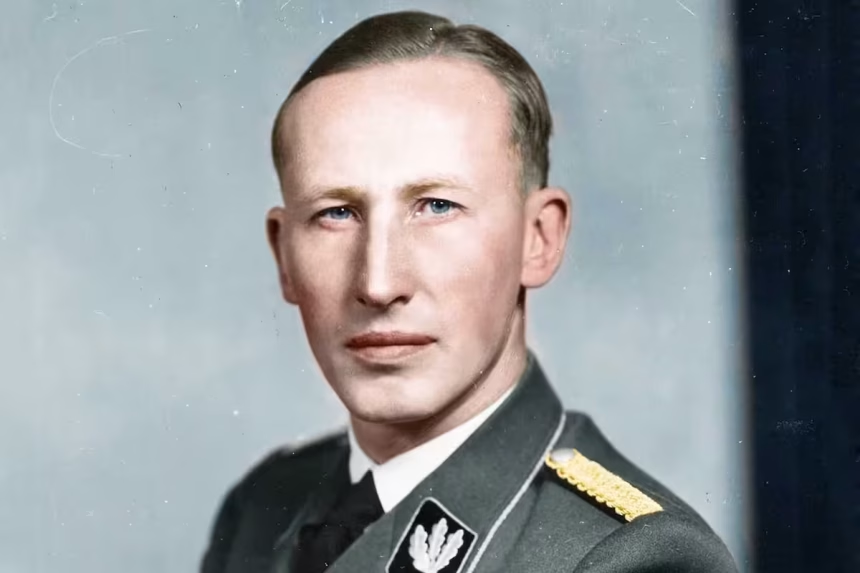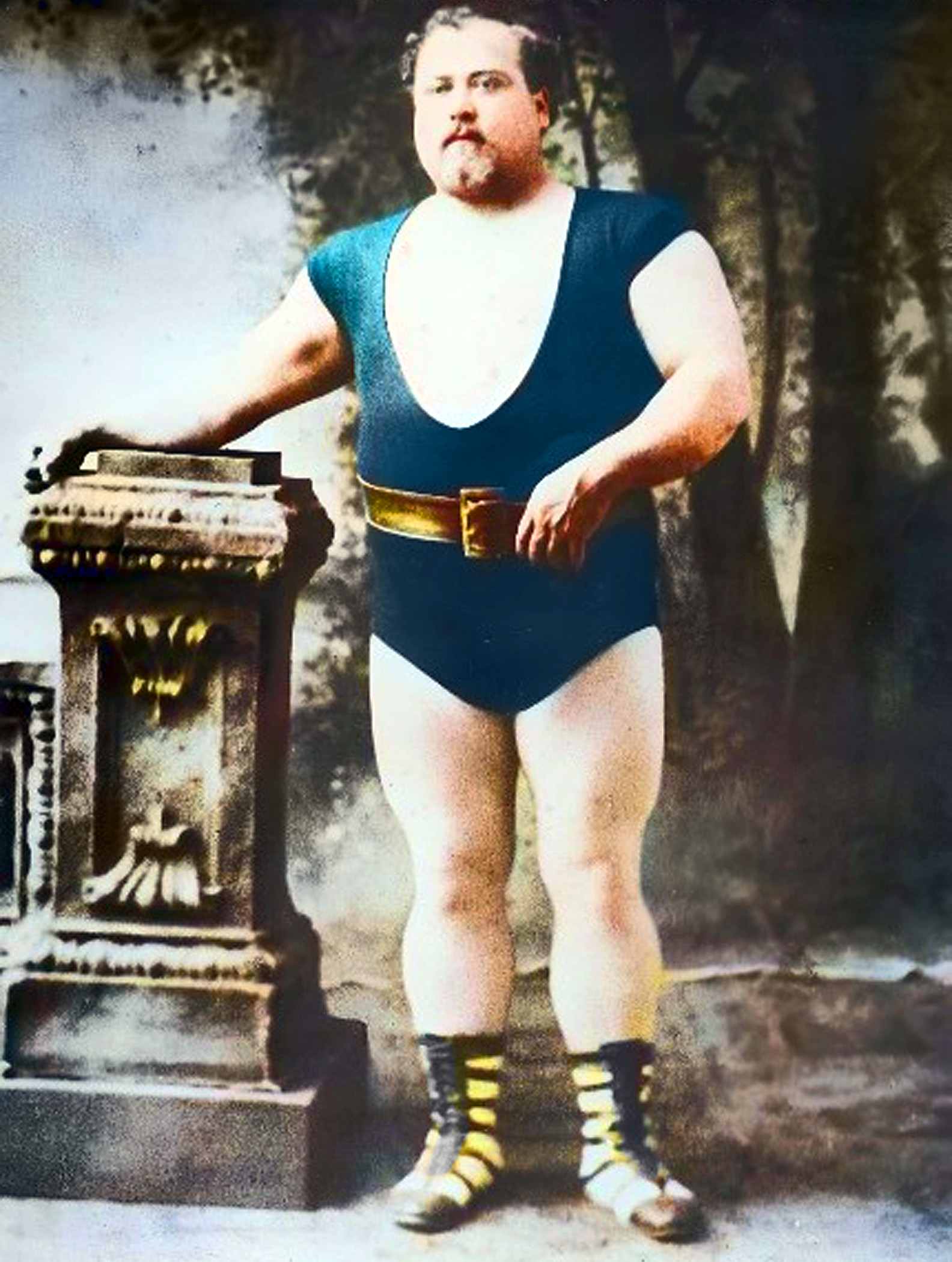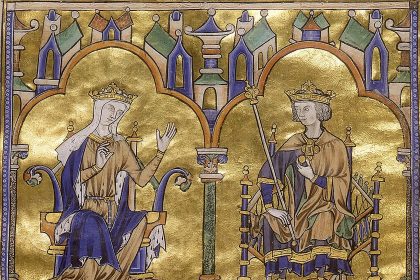The May sun beats down on Jozef Gabcik. For over an hour, the 30-year-old Czechoslovak has been waiting impatiently at a tram stop in the Prague suburb of Libeň. The morning heat is so intense that sweat beads on Gabcik’s forehead.
- The Navy Banishes Reinhard Heydrich
- Reinhard Heydrich Joins the SS
- Reinhard Heydrich Collects Information on Top Nazis
- Reinhard Heydrich’s Masterstroke
- Reinhard Heydrich Was Feared and Friendless
- Heydrich Conceives the Holocaust
- Reinhard Heydrich Becomes Prague’s Brutal Ruler
- Reinhard Heydrich Fears No One
- Death in Prague
Nevertheless, he has brought a raincoat, draped over his arm. Beneath the coat, Gabcik conceals a submachine gun.
The English-made Sten Gun Mk II FF 209 is intended to kill the head of the Gestapo, Reinhard Heydrich. Over the past year, the hated top Nazi has ruled Bohemia and Moravia—modern-day Czechia—with cynical brutality. Today, he is to die.
Across the street, the 28-year-old Jan Kubis leans casually against a lamppost. In his hand, the resistance fighter holds a suitcase containing two bombs.
For the two men, there is nothing to do but wait. Sooner or later, Heydrich’s black Mercedes convertible must appear, as reliable intelligence reports that Hitler’s henchman will be driving here this very morning.
On this sunny spring day in 1942, Reinhard Heydrich stands at the height of his Nazi career. As second-in-command of the SS and head of both the intelligence service SD and the secret police Gestapo, the 38-year-old Heydrich has, in just ten years, secured a central role in the Third Reich’s leadership.
He is also the de facto ruler of Bohemia and Moravia—present-day Czechia—where he resides in the ancient royal castle overlooking Prague.
Suddenly, a glint of light strikes the eyes of the two partisans: the long-awaited signal comes from the street ahead, where lookout Josef Valcik has been watching for Heydrich for the past hour.
It is 10:30 a.m. on May 27, 1942, and suddenly everything happens very quickly. Gabcik sprints across the street to Kubis just as a tram stops to unload passengers.
And then the black Mercedes 320 with the license plate SS-3 comes into view. To the resistance fighters’ relief, only the driver and the tall, blond Heydrich are in the Mercedes. Reinhard Heydrich sits calmly in the car’s back seat.
The sharp curve where Kubis and Gabcik are positioned forces the driver to slow down. When the car is just three meters away from Gabcik, the Czech throws off the raincoat, reveals his submachine gun, and pulls the trigger.
But nothing happens. The weapon is jammed with bits of vegetables Gabcik had carried in his inner pocket.
As the Czech frantically fumbles with his weapon, Reinhard Heydrich orders his driver to stop. Fearlessly, Heydrich rises from the back seat of the open car, draws his pistol, and aims directly at the Czech resistance fighter.
The Gestapo chief pulls the trigger, but nothing happens—just a hollow click. The pistol is not loaded.
The Navy Banishes Reinhard Heydrich
The story of “the Blond Beast’s” rise to the top of the Nazi hierarchy, however, begins far from the Czech capital, with a far less self-assured Reinhard Heydrich.
In the spring of 1931, the then 27-year-old German’s life has completely fallen apart. For several days, he locks himself in his room at his parents’ home in the southeastern German city of Halle, weeping in anger and self-pity over the injustice he feels he has suffered.
A woman claims Heydrich promised to marry her. Heydrich insists he had every right to leave her for the young, fervent Nazi Lina von Osten.
Before a naval court of honor, Heydrich denies having promised the abandoned woman anything and arrogantly declares his total lack of understanding for the court’s interference in what he, as a naval officer, should and should not do.
The attitude does not sit well with the navy’s leaders, and the young lieutenant’s dreams of a naval career crash when he is expelled from the navy.
The atmosphere at his parents’ home only deepens Heydrich’s depression. The respectable bourgeois family has been hit hard by the economic crisis.
His father is too ill to work, and his once-renowned music conservatory in Halle is losing its state authorization.
And shockingly, Heydrich’s mother must now do the housework herself while supporting the family’s three adult children by giving piano lessons to the bourgeoisie.
Reinhard Heydrich Joins the SS
For months, Reinhard Heydrich and Lina von Osten despair over their future. The solution comes from Heydrich’s mother, who is deeply worried about her son’s depression.
Through a friend, she learns that the National Socialist German Workers’ Party is looking for a man for Hitler’s newly established SS bodyguard—a position that, not insignificantly, would allow little “Reini” to wear a striking black SS uniform instead of the lost naval attire.
Heydrich immediately joins the Nazi Party, a prerequisite for the job, and on Lina’s 20th birthday, June 14th, he travels to Munich to meet SS leader Heinrich Himmler. According to Lina, it was “the most brilliant day of my life, of our life.”
Himmler receives Heydrich at his small poultry farm on the outskirts of Munich and is immediately impressed by Heydrich’s “Aryan” appearance.
He gives the enthusiastic guest 15 minutes to solve a task: Heydrich must outline how he envisions organizing the party’s future intelligence service.
Only then does Heydrich realize what the position actually entails, but he dives into the task, combining his naval experience with the intelligence methods he’s read about in his beloved British spy novels.
The result pleases Heinrich Himmler: “Good, I’ll take you,” the 30-year-old SS chief curtly declares. The two men agree on a modest starting salary of 120 Reichsmarks.
Reinhard Heydrich Collects Information on Top Nazis
In the early 1930s, Adolf Hitler’s party is plagued by internal power struggles, which Heydrich quickly learns to exploit to his advantage.
From his modest office in the party headquarters in Munich, where he initially shares a typewriter with another party functionary, he tirelessly gathers useful information on the Nazi Party’s friends and enemies.
Initially, Heydrich’s collection is just a few paper cards in a cigar box, containing intelligence on selected individuals, but in three years, it grows into an extensive and well-organized file system. By 1934, Heydrich has become the most informed man in the Nazi system.
He knows the most unpleasant, personal incidents from Hitler’s youth. He is aware of Goebbels’ sexual escapades, Göring’s morphine addiction, and the stomach cramps Himmler tries to conceal to appear as a strong and invulnerable Germanic warrior.
Heydrich possesses compromising information on nearly everyone, which can be used later if needed. The first time Heydrich’s file system is put to serious use is shortly after Hitler’s takeover in 1933.
Heydrich’s security service SD (Sicherheitsdienst) establishes the Nazis’ first concentration camp in Dachau, where communists, socialists, intellectuals, and critical artists are among the first detainees.
Reinhard Heydrich’s Masterstroke
In recognition of his efforts, Heydrich is promoted in April 1934 from head of the SD to also head of the secret police, the Gestapo.
Later that year, he delivers his masterstroke during the Night of the Long Knives, when Adolf Hitler decides to neutralize his own stormtroopers in the SA.
Heydrich quickly compiles a list of SA leaders to be eliminated, drawing from his collection of thousands of files.
While Hitler and Himmler select the primary targets, Heydrich himself eagerly signs execution orders. In total, 89 people are killed between June 30 and July 2, all without a trace of a trial.
Among those executed is former party organizer Gregor Strasser, dragged into Gestapo headquarters in Berlin and shot before Heydrich’s eyes. The Gestapo chief exclaims, “Is he not dead yet? Let the swine bleed!”
With those words, Heydrich leaves his former comrade to die alone in a prison cell.
Reinhard Heydrich Was Feared and Friendless
The situation is typical for Heydrich, who does not build his career through personal relationships. Instead, he climbs to the top through his immense work effort.
He always ensures he is one step ahead—especially in relation to Himmler, whom he repeatedly checkmates with his well-prepared and razor-sharp arguments, leaving the SS chief with little choice but to follow his deputy’s advice.
“Heydrich is undoubtedly far superior to Himmler. He is well aware of this himself and expresses his superiority through his elegant reports. Himmler is simply incapable of matching him,” notes Himmler’s masseur, who often has the opportunity to observe the two men up close.
Consistently, Heydrich insists on never addressing Himmler with anything other than the formal “Sie” instead of the familiar “du.” He fears that informal address would render him unable to make convincing arguments against his superior.
At times, Himmler seems almost mentally violated after a report from Heydrich.
Heydrich Conceives the Holocaust
Even the highest SS leader, Heinrich Himmler, generally avoids direct confrontations with his closest subordinate, and Heydrich is even more feared by his own employees.
He acts coldly and purposefully, keeping his eyes fixed firmly on the goal: paving the way for the Führer’s vision of a Greater Germanic Reich.
As early as the late 1930s, Heydrich is among the first to become convinced that a natural consequence of Greater Germany is the removal of Europe’s Jews.
Whether they should be deported to Madagascar or Siberia, shot en masse, or gassed—all options Heydrich considers—matters less.
The most important thing is that the plan is efficient. For a long time, he grapples with the logistical problems of extermination. Finally, in January 1942, he proudly presents “the final solution” to the Jewish question in a villa in the Berlin district of Wannsee.
The so-called Wannsee Conference becomes Heydrich’s greatest moment as a Nazi. The cynical groundwork has been carried out to perfection. Europe’s Jews have been counted, and the concentration camps are ready.
The railway network is functioning well, and Zyklon-B gas has proven to be immensely effective. With Hitler’s and Himmler’s approval, Heydrich can set the Holocaust in motion.
Simultaneously, Heydrich is personally chosen by Hitler to bring order to the turbulent Protectorate of Bohemia and Moravia (modern-day Czech Republic).
Due to the extensive arms production in Bohemia, the area is especially important for the Führer to control, and Heydrich’s predecessor has been sent on sick leave for failing to keep the Czechs sufficiently in check.
Reinhard Heydrich Becomes Prague’s Brutal Ruler
Heydrich approaches the task with focused severity. In a speech to his employees upon taking office, he explains how the Czechs can broadly be divided into two groups:
One half can be Germanized—made into Germans—while the other half, in his view, can be deported to Siberia once the Soviet Union is annexed by the Reich.
To distinguish the “good” Czechs from the “bad,” Heydrich rules his protectorate from the outset with a calculated mix of carrot and stick: He immediately declares a state of emergency and cracks down hard on the well-established Czech resistance movement.
404 people are executed, and more than 4,000 are sent to Gestapo torture chambers, while the deportation of Prague’s Jews begins.
The Czech prime minister is arrested just hours after Heydrich’s arrival, and within a week, the minister is both tried and sentenced to death for collaborating with the British.
To soften public sentiment, Heydrich simultaneously increases food rations, establishes soup kitchens for the poor, eases access to tobacco, and launches an intensive crackdown on black market traders, who are widely despised by the population.
The new governor also meets with representatives of workers at Prague’s Hradcany Castle, calls them “comrades,” and promises to meet their demands.
Reinhard Heydrich Fears No One
The strategy works to a large extent—the mood among the general population eases, while the resistance movement is decimated within a few months: Its leaders are incapacitated, and the population too terrified to support it.
After his successful efforts, Heydrich settles with his family at the Panenské Brežany castle north of Prague.
Here, he leads a comfortable life as the Czechs’ Germanic ruler, while commuting to Berlin twice a week to fulfill his duties as head of the Reich’s security services.
Proud, conscious of honor, and convinced of his Czech subjects’ full respect, Heydrich always travels around Prague unprotected. As he reasons: “Why would my Czechs shoot me?”
Death in Prague
When Reinhard Heydrich raises his pistol inside his official car on a street corner in Prague and aims at Czech partisan Jozef Gabčík, the gas chambers of the concentration camps have only just become operational, and his Führer’s vision of a racially pure Greater Reich still seems within reach.
But Heydrich never lives to see the Third Reich’s ultimate fate. As he squeezes the trigger on his unloaded pistol, Gabčík’s comrade Jan Kubiš throws one of his bombs toward the black Mercedes.
The throw is too short, and the bomb explodes near the car’s right rear wheel, but it proves enough: The explosion drives metal fragments from the car and horsehair from the seat padding into Heydrich’s back.
Although Heydrich—according to legend—pursues his assassins despite his injuries, he soon collapses on a street corner. At the nearby Bulovka Hospital, the Gestapo chief initially recovers, but then falls into a coma.
Reinhard Heydrich dies seven days later from blood poisoning.






